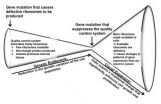(Press-News.org) Evidence left at the crime scene is abundant and global: Fossil remains show that sometime around 252 million years ago, about 90 percent of all species on Earth were suddenly wiped out — by far the largest of this planet's five known mass extinctions. But pinpointing the culprit has been difficult, and controversial.
Now, a team of MIT researchers may have found enough evidence to convict the guilty parties — but you'll need a microscope to see the killers.
The perpetrators, this new work suggests, were not asteroids, volcanoes, or raging coal fires, all of which have been implicated previously. Rather, they were a form of microbes — specifically, methane-producing archaea called Methanosarcina — that suddenly bloomed explosively in the oceans, spewing prodigious amounts of methane into the atmosphere and dramatically changing the climate and the chemistry of the oceans.
Volcanoes are not entirely off the hook, according to this new scenario; they have simply been demoted to accessories to the crime. The reason for the sudden, explosive growth of the microbes, new evidence shows, may have been their novel ability to use a rich source of organic carbon, aided by a sudden influx of a nutrient required for their growth: the element nickel, emitted by massive volcanism at just that time.
The new solution to this mystery is published this week in the Proceedings of the National Academy of Sciences by MIT professor of geophysics Daniel Rothman, postdoc Gregory Fournier, and five other researchers at MIT and in China.
The researchers' case builds upon three independent sets of evidence. First, geochemical evidence shows an exponential (or even faster) increase of carbon dioxide in the oceans at the time of the so-called end-Permian extinction. Second, genetic evidence shows a change in Methanosarcina at that time, allowing it to become a major producer of methane from an accumulation of carbon dioxide in the water. Finally, sediments show a sudden increase in the amount of nickel deposited at exactly this time.
The carbon deposits show that something caused a significant uptick in the amount of carbon-containing gases — carbon dioxide or methane — produced at the time of the mass extinction. Some researchers have suggested that these gases might have been spewed out by the volcanic eruptions that produced the Siberian traps, a vast formation of volcanic rock produced by the most extensive eruptions in Earth's geological record. But calculations by the MIT team showed that these eruptions were not nearly sufficient to account for the carbon seen in the sediments. Even more significantly, the observed changes in the amount of carbon over time don't fit the volcanic model.
"A rapid initial injection of carbon dioxide from a volcano would be followed by a gradual decrease," Fournier says. "Instead, we see the opposite: a rapid, continuing increase."
"That suggests a microbial expansion," he adds: The growth of microbial populations is among the few phenomena capable of increasing carbon production exponentially, or even faster.
But if living organisms belched out all that methane, what organisms were they, and why did they choose to do so at that time?
That's where genomic analysis can help: It turns out that Methanosarcina had acquired a particularly fast means of making methane, through gene transfer from another microbe — and the team's detailed mapping of the organism's history now shows that this transfer happened at about the time of the end-Permian extinction. (Previous studies had only placed this event sometime in the last 400 million years.) Given the right conditions, this genetic acquisition set the stage for the microbe to undergo a dramatic growth spurt, rapidly consuming a vast reserve of organic carbon in the ocean sediments.
But there is one final piece to the puzzle: Those organisms wouldn't have been able to proliferate so prodigiously if they didn't have enough of the right mineral nutrients to support them. For this particular microbe, the limiting nutrient is nickel — which, new analysis of sediments in China showed, increased dramatically following the Siberian eruptions (which were already known to have produced some of the world's largest deposits of nickel). That provided the fuel for Methanosarcina's explosive growth.
The resulting outburst of methane produced effects similar to those predicted by current models of global climate change: a sudden, extreme rise in temperatures, combined with acidification of the oceans. In the case of the end-Permian extinction, virtually all shell-forming marine organisms were wiped out — consistent with the observation that such shells cannot form in acidic waters.
"A lot of this rests on the carbon isotope analysis," Rothman says, which is exceptionally strong and clear in this part of the geological record. "If it wasn't such an unusual signal, it would be harder to eliminate other possibilities."
While no single line of evidence can prove exactly what happened in this ancient die-off, says Rothman, who is also director of MIT's Lorenz Center, "the cumulative impact of all these things is much more powerful than any one individually." While it doesn't conclusively prove that the microbes did it, it does rule out some alternative theories, and makes a strong and consistent case, he says.
INFORMATION:
The research was supported by NASA, the National Science Foundation, the Natural Science Foundation of China, and the National Basic Research Program of China.
Additional background
Archive:
Timeline of a mass extinction
Ancient whodunit may be solved: The microbes did it!
Methane-producing microbes may be responsible for the largest mass extinction in Earth's history
2014-03-31
ELSE PRESS RELEASES FROM THIS DATE:
Experimental cancer drug reverses schizophrenia in adolescent mice
2014-03-31
Johns Hopkins researchers say that an experimental anticancer compound appears to have reversed behaviors associated with schizophrenia and restored some lost brain cell function in adolescent mice with a rodent version of the devastating mental illness.
The drug is one of a class of compounds known as PAK inhibitors, which have been shown in animal experiments to confer some protection from brain damage due to Fragile X syndrome, an inherited disease in humans marked by mental retardation. There also is some evidence, experts say, suggesting PAK inhibitors could be used ...
Possible explanation for human diseases caused by defective ribosomes
2014-03-31
Ribosomes are essential for life, generating all of the proteins required for cells to grow. Mutations in some of the proteins that make ribosomes cause disorders characterized by bone marrow failure and anemia early in life, followed by elevated cancer risk in middle age. These disorders are generally called "ribosomopathies."
How can ribosomopathies first appear as diseases caused by too few cells, but later turn into diseases caused by too many cells? This paradox has puzzled the scientific community for years. A new study, which uses a genetic approach to examine ...
Oxygen depletion in the Baltic Sea is 10 times worse than a century ago
2014-03-31
This news release is available in German. After several years of discussions, researchers from Aarhus University (Denmark), Lund University (Sweden) and Stockholm University (Sweden) have determined that nutrients from the land are the main cause of widespread areas of oxygen depletion. The results were published on 31 March in the prestigious American journal Proceedings of the National Academy of Sciences.
Nutrients are the villain
The deepest areas of the Baltic Sea have always had a low oxygen content. The inflow of fresh water is actually limited by low thresholds ...
Scientists understand how E. coli clone has become globally distributed
2014-03-31
Scientists have for the first time come closer to understanding how a clone of E. coli, described as the most important of its kind to cause human infections, has spread across the world in a very short time.
E. coli clone ST131 is one of the leading causes of urinary tract and blood stream infections and has crossed the globe at a rapid rate. Worryingly, members of this clone are becoming more resistant to antibiotics. As an indication of scale, more than half of all women will suffer a urinary tract infection at least once in their lives. An international team of scientists, ...
Researchers announce first phononic crystal that can be altered in real time
2014-03-31
Using an acoustic metadevice that can influence the acoustic space and can control any of the ways in which waves travel, engineers have demonstrated, for the first time, that it is possible to dynamically alter the geometry of a three-dimensional colloidal crystal in real time.
The colloidal crystals designed in the study, called metamaterials, are artificially structured materials that extend the properties of existing naturally occurring materials and compounds. The research by academics from the University of Bristol's Department of Mechanical Engineering is published ...
Weaker gut instinct makes teens open to risky behavior
2014-03-31
DURHAM, N.C. -- Making a snap decision usually means following your initial reaction -- going with your gut. That intuitive feeling sprouts from the limbic system, the evolutionarily older and simpler part of the brain that affects emotion, behavior and motivation.
But during adolescence, the limbic system connects and communicates with the rest of the brain differently than it does during adulthood, leaving many adolescents vulnerable to riskier behaviors, according to Duke University researchers.
"We know adolescence is a time of profound social change. It's also ...
New tool helps young adults with sickle cell disease in the transition to adult care
2014-03-31
(Boston) – Child and adolescent hematologists at Boston Medical Center (BMC) have developed a tool to gauge how ready young adults with sickle cell disease are for a transition into adult care. In a new article for the Journal of Pediatric Hematology/Oncology, Amy Sobota, MD, MPH, and her collaborators have shown that a questionnaire geared to the needs of young adults with sickle cell disease can pinpoint areas of need before the patient goes into an adult clinic.
BMC's sickle cell disease transition clinic, which is unique in Boston, was established in 2008 and serves ...
Vibration may help heal chronic wounds
2014-03-31
Wounds may heal more quickly if exposed to low-intensity vibration, report researchers at the University of Illinois at Chicago.
The finding, in mice, may hold promise for the 18 million Americans who have type 2 diabetes, and especially the quarter of them who will eventually suffer from foot ulcers. Their wounds tend to heal slowly and can become chronic or worsen rapidly.
Timothy Koh, UIC professor of kinesiology and nutrition in the UIC College of Applied Health Sciences, was intrigued by studies at Stony Brook University in New York that used very low-intensity ...
Kinder, gentler med school: Students less depressed, learn more
2014-03-31
ST. LOUIS -- Removing pressure from medical school while teaching students skills to manage stress and bounce back from adversity improves their mental health and boosts their academic achievement, Saint Louis University research finds.
Stuart Slavin, M.D., M.Ed., associate dean for curriculum at SLU School of Medicine, is the lead author of the paper, which is published the April edition of Academic Medicine. The problem of depression among medical school students is significant, Slavin said, affecting between 20 and 30 percent of medical students in the U.S., and potentially ...
Poor sleep quality linked to cognitive decline in older men
2014-03-31
DARIEN, IL – A new study of older men found a link between poor sleep quality and the development of cognitive decline over three to four years.
Results show that higher levels of fragmented sleep and lower sleep efficiency were associated with a 40 to 50 percent increase in the odds of clinically significant decline in executive function, which was similar in magnitude to the effect of a five-year increase in age. In contrast, sleep duration was not related to subsequent cognitive decline.
"It was the quality of sleep that predicted future cognitive decline in this ...
LAST 30 PRESS RELEASES:
Numbers in our sights affect how we perceive space
SIMJ announces global collaborative book project in commemoration of its 75th anniversary
Air pollution exposure and birth weight
Obstructive sleep apnea risk and mental health conditions among older adults
How talking slows eye movements behind the wheel
The Ceramic Society of Japan’s Oxoate Ceramics Research Association launches new international book project
Heart-brain connection: international study reveals the role of the vagus nerve in keeping the heart young
Researchers identify Rb1 as a predictive biomarker for a new therapeutic strategy in some breast cancers
Survey reveals ethical gaps slowing AI adoption in pediatric surgery
Stimulant ADHD medications work differently than thought
AI overestimates how smart people are, according to HSE economists
HSE researchers create genome-wide map of quadruplexes
Scientists boost cell "powerhouses" to burn more calories
Automatic label checking: The missing step in making reliable medical AI
Low daily alcohol intake linked to 50% heightened mouth cancer risk in India
American Meteorological Society announces Rick Spinrad as 2026 President-Elect
Biomass-based carbon capture spotlighted in newly released global climate webinar recording
Illuminating invisible nano pollutants: advanced bioimaging tracks the full journey of emerging nanoscale contaminants in living systems
How does age affect recovery from spinal cord injury?
Novel AI tool offers prognosis for patients with head and neck cancer
Fathers’ microplastic exposure tied to their children’s metabolic problems
Research validates laboratory model for studying high-grade serous ovarian cancer
SIR 2026 delivers transformative breakthroughs in minimally invasive medicine to improve patient care
Stem Cell Reports most downloaded papers of 2025 highlight the breadth and impact of stem cell research
Oxford-led study estimates NHS spends around 3% of its primary and secondary care budget on the health impacts of heat and cold in England
A researcher’s long quest leads to a smart composite breakthrough
Urban wild bees act as “microbial sensors” of city health.
New study finds where you live affects recovery after a hip fracture
Forecasting the impact of fully automated vehicle adoption on US road traffic injuries
Alcohol-related hospitalizations from 2016 to 2022
[Press-News.org] Ancient whodunit may be solved: The microbes did it!Methane-producing microbes may be responsible for the largest mass extinction in Earth's history




